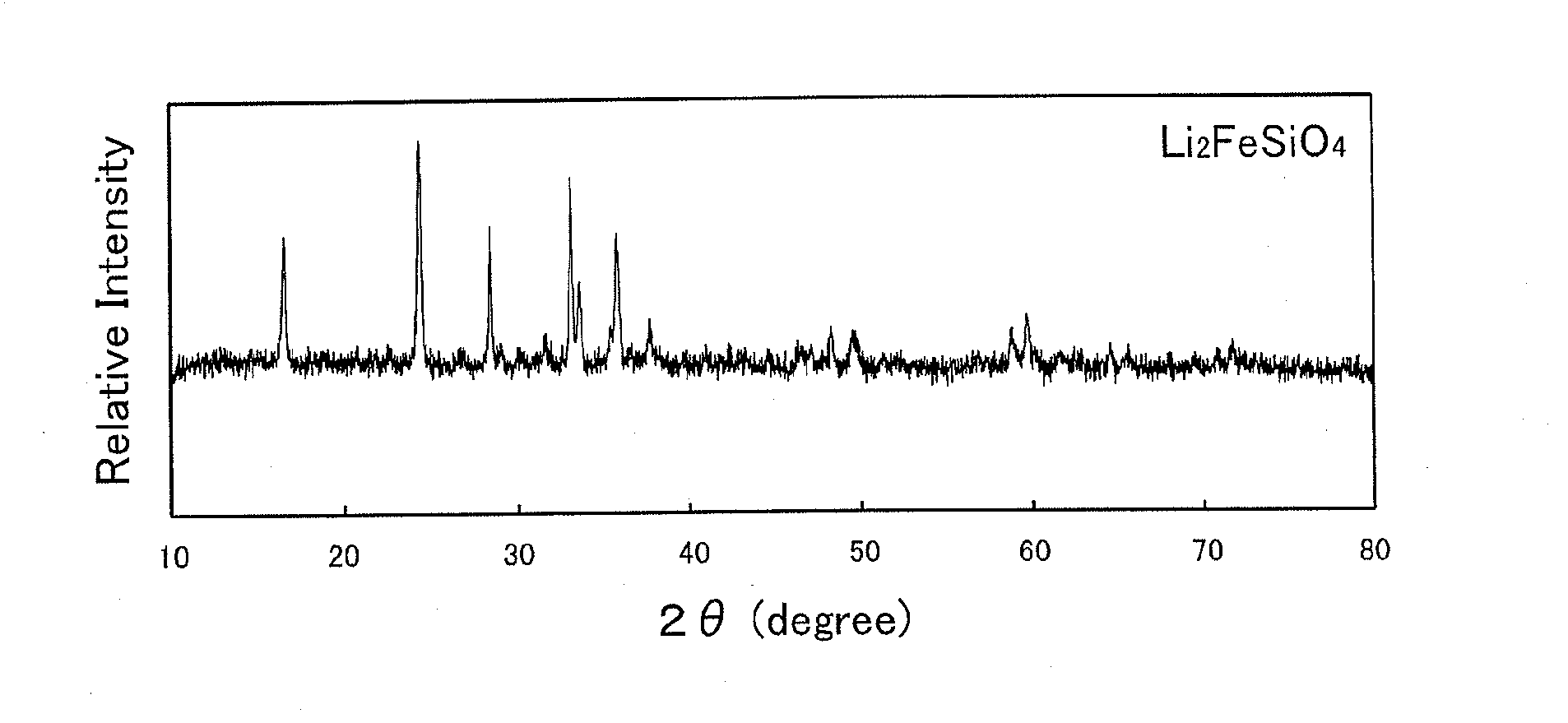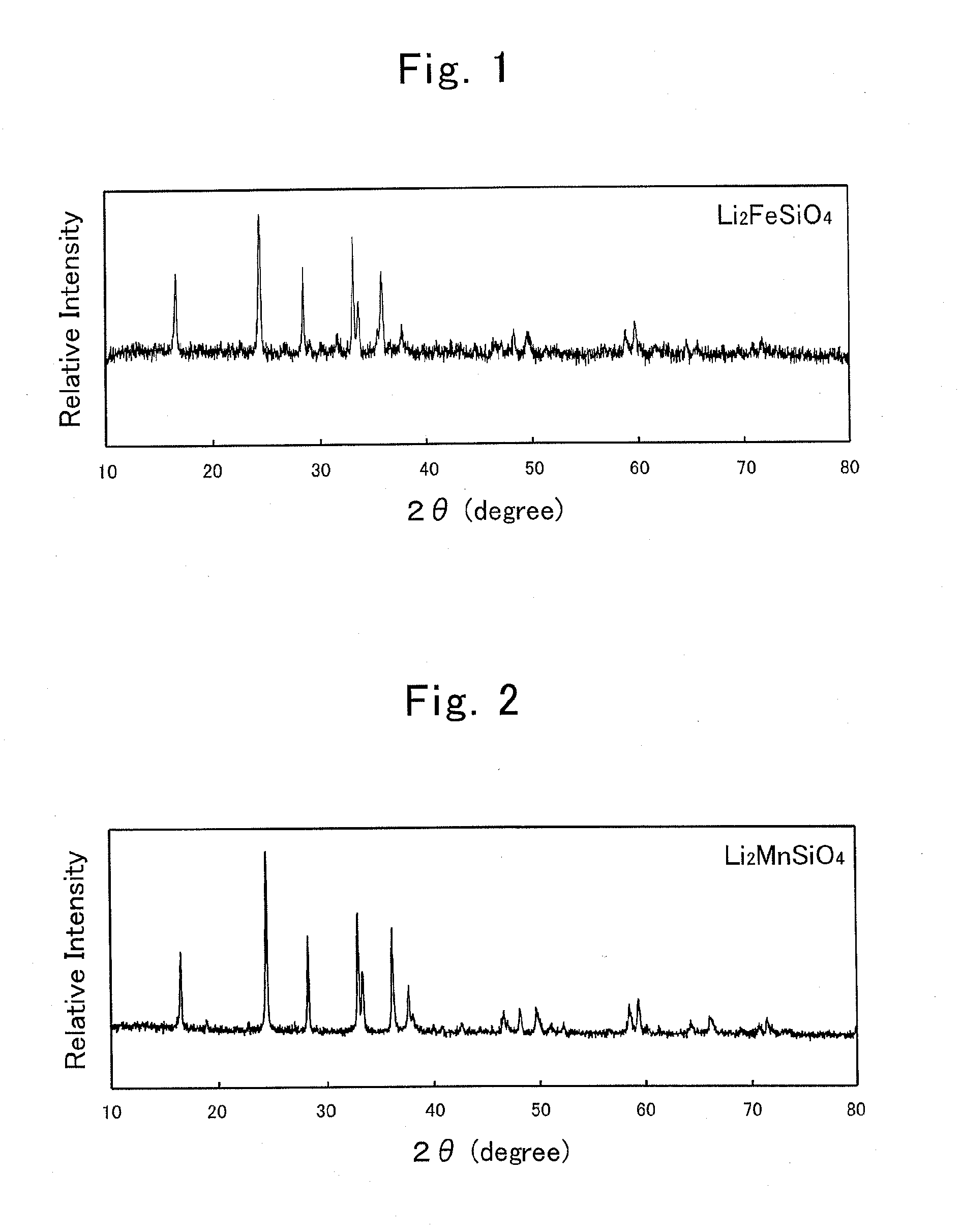Production process for lithium-silicate-based compound
a lithium-silicate, production process technology, applied in silicon compounds, silicates, cell components, etc., can solve the problems of difficult to retard impurities from generating, and achieve the effect of less environment, less expensive, and excellent battery characteristics
- Summary
- Abstract
- Description
- Claims
- Application Information
AI Technical Summary
Benefits of technology
Problems solved by technology
Method used
Image
Examples
examples
[0106]Hereinafter, the present invention will be explained in more detail while giving examples.
example no.1
Example No. 1
Synthesis of Iron-Containing Lithium-Silicate Compound
[0107]20-mL acetone was added to a mixture of 0.03 mol of iron (produced by KOHJUNDO KAGAKU Co. Ltd., and with 99.9% purity), and 0.03 mol of lithium silicate, Li2SiO3 (produced by KISHIDA KAGAKU Co. Ltd., and with 99.5% purity), and was dried after being mixed with the mixture by a ball mill made of zirconia at a rate of 500 rpm for 60 minutes. This one was further mixed in a mortar along with a nitrate mixture. The used nitrate mixture was one in which lithium nitrate (produced by KISHIDA KAGAKU, and with 99% purity) and potassium nitrate (produced by KISHIDA KAGAKU, and with 99% purity) were mixed in such a ratio as (Lithium Nitrate):(Potassium Nitrate) being equal to 41:59 by molar ratio. Moreover, a proportion of the nitrate mixture was set at 120 parts by mass with respect to a summed amount of the iron and lithium silicate being taken as 100 parts by mass.
[0108]The thus obtained powder was heated in a golden c...
example no.2
Example No. 2
Synthesis of Manganese-Containing Lithium-Silicate Compound
[0113]Instead of the iron used in Example No. 1, manganese oxide (II) (produced by KOHJUNDO KAGAKU Co. Ltd., and with 99.9% purity) was used in an amount of 0.03 mol, and then a powder of manganese-containing lithium-silicate-based compound was obtained under the same synthesis conditions as those of Example No. 1.
[0114]An X-ray diffraction measurement was carried out for the obtained product by means of a powder X-ray diffraction apparatus with use of the CuKα ray. The resulting XRD pattern is shown in FIG. 2. The XRD pattern of this product agreed with the XRD pattern of orthorhombic-crystal Li2MnSiO4 in the space group “Pmn21” virtually.
[0115]Moreover, when observing the obtained product with use of a transmission electron microscope (or TEM), particles whose particle diameters were from 50 nm to 15 μm approximately were observed. When calculating the average particle diameter, it was 300 nm.
PUM
| Property | Measurement | Unit |
|---|---|---|
| discharging voltages | aaaaa | aaaaa |
| particle diameters | aaaaa | aaaaa |
| temperatures | aaaaa | aaaaa |
Abstract
Description
Claims
Application Information
 Login to View More
Login to View More - R&D
- Intellectual Property
- Life Sciences
- Materials
- Tech Scout
- Unparalleled Data Quality
- Higher Quality Content
- 60% Fewer Hallucinations
Browse by: Latest US Patents, China's latest patents, Technical Efficacy Thesaurus, Application Domain, Technology Topic, Popular Technical Reports.
© 2025 PatSnap. All rights reserved.Legal|Privacy policy|Modern Slavery Act Transparency Statement|Sitemap|About US| Contact US: help@patsnap.com


